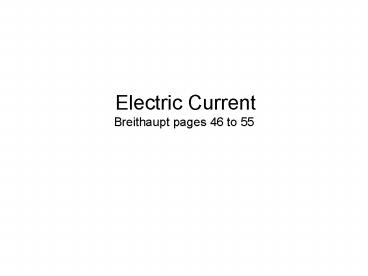Electric Current Breithaupt pages 46 to 55
1 / 6
Title:
Electric Current Breithaupt pages 46 to 55
Description:
Electric current as the rate of flow of charge. I = ?Q / ?t ... What is an electric current? ... Copy and learn the component symbols on page 53 ... –
Number of Views:41
Avg rating:3.0/5.0
Title: Electric Current Breithaupt pages 46 to 55
1
Electric CurrentBreithaupt pages 46 to 55
2
AS specification
- Electric current as the rate of flow of charge
- I ?Q / ?t
- Potential difference as work done per unit
charge. - V W / Q
- W W x I x t P I x V
- Resistance is defined by R V / I
- Ohms law.
- ? RA / L
- Superconductivity as a property of certain
materials which have zero resistivity at and
below a critical temperature which depends on the
material. Applications (e.g. very strong
electromagnets, power cables). - For an ohmic conductor, a semiconductor diode and
a filament lamp candidates should have
experience of the use of a current sensor and a
voltage sensor with a data logger to capture data
from which to determine V-I curves. - Ohms law as a special case where I a V.
- Description of the qualitative effect of
temperature on the resistance of metal conductors
and thermistors. Applications (e.g. temperature
sensors).
3
4.1 Current and chargeNotes from Breithaupt
pages 46 47
- What is an electric current?
- State the relationship between charge and current
and give a sample calculation. - Explain the different ways in which a substance
can conduct electricity. - Draw figure 2 on page 46 and hence explain the
direction of current flow through a metal. - Try the summary questions on page 47
4
4.2 Potential difference and powerNotes from
Breithaupt pages 48 49
- Define potential difference and give the equation
for potential difference in terms of charge and
work done. - What is electromotive force?
- Show how the equation P IV can be derived from
the equations defining current and voltage. - Explain how the concept of potential difference
arises from the energy transfers in an electrical
circuit. - Calculate the p.d. if a charge of 50C requires
300J of work. - Calculate the current drawn by a 15W device from
a 12V power supply. - Try the summary questions on page 49
5
4.3 ResistanceNotes from Breithaupt pages 50 to
52
- What is resistance? Give the equation defining
resistance and a sample resistance calculation. - What is Ohms law? How can Ohms law be verified
graphically? - Give the equation for resistivity.
- What is superconductivity? When does it occur?
Give two applications. - Draw a circuit diagram and explain how resistance
can be measured. - Calculate the resistance of a copper wire of
diameter 1mm and length 3m. - Compare the resistivities of copper, silicon and
PVC. - Try the summary questions on page 52
6
4.4 Components and their characteristicsNotes
from Breithaupt pages 53 to 55
- Sketch and explain the shapes of the
characteristic curves of (a) a metal wire (b) a
lamp (c) a thermistor (d) a diode - Describe and explain the resistance variation
with temperature of (a) metallic conductors (b)
semiconductors - Copy and learn the component symbols on page 53
- What is (a) a battery (b) resistor (c)
thermistor (d) LDR (e) diode (f) LED? - What is the purpose of a characteristic curve?
Explain, with the aid of a circuit diagram, how
one can be produced - Try the summary questions on page 55











![L 27 Electricity and Magnetism [4]](https://s3.amazonaws.com/images.powershow.com/7347050.th0.jpg?_=20151107026)



















